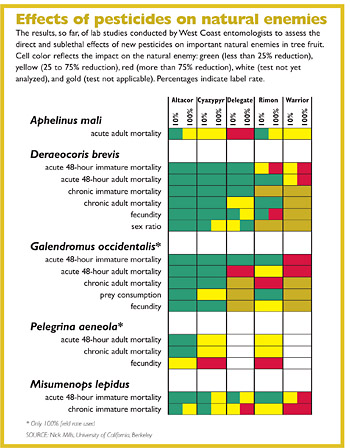
In the cherry orchards of northwest Michigan around Traverse City, growers use a mixture of methods to control their archenemies: cherry fruit fly, plum curculio, and cherry leaf spot.
Some growers use airblast sprayers while others use air-curtain sprayers. Some run their sprayers down the middle of every tree row (ERM) and apply spray to both sides of every tree, and some skip a row (alternate row middle, or ARM) and spray every other row, often tightening up intervals.
All growers use the recommended rates of chemicals—so many ounces per hundred gallons of water, but those using ARM spray only one side of the trees. At the end of the season, ERM and ARM strategies do apply a similar amount of material, but the ARM ultimately uses less, depending on interval timing. When growers use ARM, they usually shorten the interval between sprays from ten-plus days down to about seven, but either way the ARM users spend less time and fuel spraying their orchards.
Research 20 years ago established that ARM worked pretty well, says Dr. Nikki Rothwell, the entomologist who coordinates research and extension at the Northwest Michigan Horticultural Research Station. “In 1993, Dr. Alan Jones (who was then Michigan’s fruit disease control authority) showed that a seven-day ARM schedule worked as well as a ten-day ERM schedule for disease control under moderate disease pressure,” she said.
“But back then, we had effective sterol inhibitor fungicides that still had kickback action, and today, SIs do not control cherry leaf spot at all. Additionally, all of our insecticide options had quick knockdown action. Now, growers have no fungicides with back action, and the new insecticides have different modes of action, such as anti-ovipositional and repellent properties, and we have to investigate if ARM is still effective. ARM saves growers time and money, so we don’t want to leave it behind. But we need effective pest control.”
Air-curtain sprayers
While tart cherry growers tend to use ARM, she said, many sweet cherry growers have moved away from it. Trees are often bigger, options for pesticides are more limited, and growers believe ERM spray applications work better. Some use air-curtain sprayers early in the season and shift to airblast sprayers as fruit ripens, believing the high air volume physically moves the cherries, giving better penetration of clusters for control of brown rot. The air-curtain sprayer relies more heavily on a swirling mist of smaller droplets for coverage.
This year will be Rothwell’s third year of research sorting out the variables. She’s comparing ARM and ERM using the two different sprayer types and two kinds of insecticides, those that give quick knockdown through contact and those that depend on ingestion. This year she’s adding fungicides to the studies, which, up until now, have focused on insecticides.
Past studies have focused on deposition patterns and residues. Now, she will evaluate the efficacy of the materials by using fruit injury to determine insect damage and disease rating and defoliation to measure cherry leaf spot infection. The new insecticides work in different ways, so fruit injury gives a better rating than counting dead insects, she said.
Last year, she found that air-curtain sprayers gave better blow-through than did airblast sprayers. Airblast sprayers tended to overspray the side of the row closest to the sprayer, and provided adequate coverage through the tree, but the spray did not carry to the next row over. The air-curtain sprayer gave good coverage in the trees being sprayed, and some coverage to trees in the next row.
Because of the fast knockdown and mode of action of the older insecticides, Rothwell found that airblast sprayers deposited more insecticide than was needed closest to the sprayer and had best results in row one. The air-curtain sprayer, applying a contact insecticide, gave 100 percent mortality in both row 1 and row 2. ARM worked well with insecticides with that mode of action and that sprayer technology.
In the past, the tests were limited in time. This year, Rothwell plans a full-scale, season-long trial, rating fruit injury from insects and leaf loss from cherry leaf spot. She will compare ARM and ERM and both sprayer types.
Her answers, if all goes well, will be more definitive next year.

Leave A Comment